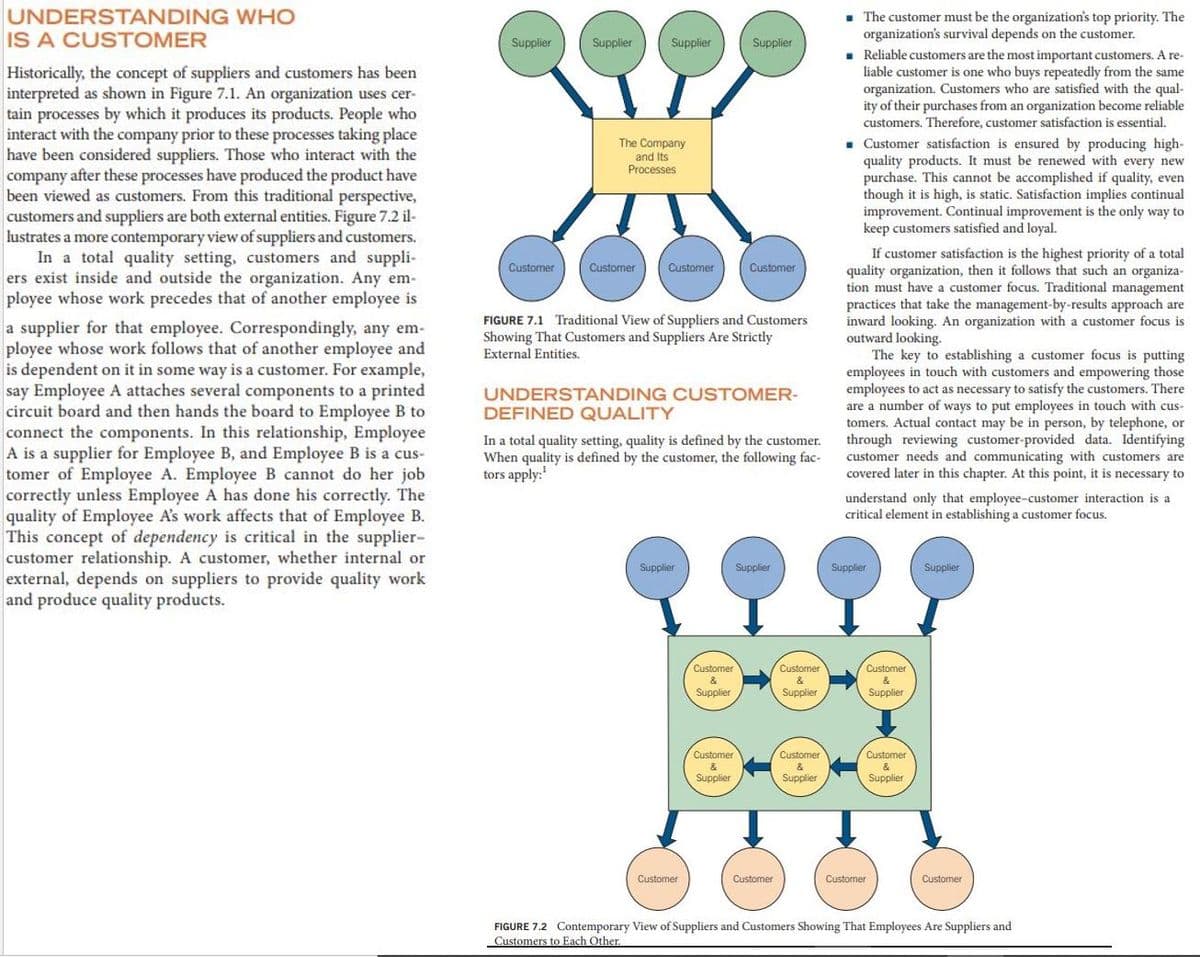Principles Of Marketing
17th Edition
ISBN:9780134492513
Author:Kotler, Philip, Armstrong, Gary (gary M.)
Publisher:Kotler, Philip, Armstrong, Gary (gary M.)
Chapter1: Marketing: Creating Customer Value And Engagement
Section: Chapter Questions
Problem 1.1DQ
Related questions
Question
Please I really need help, I begging you
Read the pages and make a brief summary of them with your own words, please. It is what you understand. Don't make copy-paste, please. Mention important parts only. Also, you will put your comments and ideas about the topic. Write your comments and opinions briefly on the subject in a separate paragraph at the bottom. Please don't write item by item. Write the summary in paragraph form.

Transcribed Image Text:UNDERSTANDING WHO
IS A CUSTOMER
- The customer must be the organization's top priority. The
organization's survival depends on the customer.
• Reliable customers are the most important customers. A re-
liable customer is one who buys repeatedly from the same
organization. Customers who are satisfied with the qual-
ity of their purchases from an organization become reliable
customers. Therefore, customer satisfaction is essential.
Supplier
Supplier
Supplier
Supplier
Historically, the concept of suppliers and customers has been
interpreted as shown in Figure 7.1. An organization uses cer-
tain processes by which it produces its products. People who
interact with the company prior to these processes taking place
have been considered suppliers. Those who interact with the
company after these processes have produced the product have
been viewed as customers. From this traditional perspective,
customers and suppliers are both external entities. Figure 7.2 il-
lustrates a more contemporary view of suppliers and customers.
In a total quality setting, customers and suppli-
ers exist inside and outside the organization. Any em-
ployee whose work precedes that of another employee is
Customer satisfaction is ensured by producing high-
quality products. It must be renewed with every new
purchase. This cannot be accomplished if quality, even
though it is high, is static. Satisfaction implies continual
improvement. Continual improvement is the only way to
keep customers satisfied and loyal.
The Company
and Its
Processes
If customer satisfaction is the highest priority of a total
quality organization, then it follows that such an organiza-
tion must have a customer focus. Traditional management
practices that take the management-by-results approach are
inward looking. An organization with a customer focus is
outward looking.
The key to establishing a customer focus is putting
employees in touch with customers and empowering those
employees to act as necessary to satisfy the customers. There
are a number of ways to put employees in touch with cus-
tomers. Actual contact may be in person, by telephone, or
through reviewing customer-provided data. Identifying
customer needs and communicating with customers are
covered later in this chapter. At this point, it is necessary to
Customer
Customer
Customer
Customer
FIGURE 7.1 Traditional View of Suppliers and Customers
Showing That Customers and Suppliers Are Strictly
External Entities.
a supplier for that employee. Correspondingly, any em-
ployee whose work follows that of another employee and
is dependent on it in some way is a customer. For example,
say Employee A attaches several components to a printed
circuit board and then hands the board to Employee B to
connect the components. In this relationship, Employee
A is a supplier for Employee B, and Employee B is a cus-
tomer of Employee A. Employee B cannot do her job
correctly unless Employee A has done his correctly. The
quality of Employee A's work affects that of Employee B.
This concept of dependency is critical in the supplier-
customer relationship. A customer, whether internal or
external, depends on suppliers to provide quality work
and produce quality products.
UNDERSTANDING CUSTOMER-
DEFINED QUALITY
In a total quality setting, quality is defined by the customer.
When quality is defined by the customer, the following fac-
tors apply:
understand only that employee-customer interaction is a
critical element in establishing a customer focus.
Supplier
Supplier
Supplier
Supplier
Customer
Customer
Customer
&
Supplier
Supplier
Supplier
Customer
Customer
Customer
&
&
&
Supplier
Supplier
Supplier
Customer
Customer
Customer
Customer
FIGURE 7.2 Contemporary View of Suppliers and Customers Showing That Employees Are Suppliers and
Customers to Each Other.
Expert Solution
This question has been solved!
Explore an expertly crafted, step-by-step solution for a thorough understanding of key concepts.
Step by step
Solved in 2 steps

Recommended textbooks for you

Principles Of Marketing
Marketing
ISBN:
9780134492513
Author:
Kotler, Philip, Armstrong, Gary (gary M.)
Publisher:
Pearson Higher Education,

Marketing
Marketing
ISBN:
9781259924040
Author:
Roger A. Kerin, Steven W. Hartley
Publisher:
McGraw-Hill Education

Foundations of Business (MindTap Course List)
Marketing
ISBN:
9781337386920
Author:
William M. Pride, Robert J. Hughes, Jack R. Kapoor
Publisher:
Cengage Learning

Principles Of Marketing
Marketing
ISBN:
9780134492513
Author:
Kotler, Philip, Armstrong, Gary (gary M.)
Publisher:
Pearson Higher Education,

Marketing
Marketing
ISBN:
9781259924040
Author:
Roger A. Kerin, Steven W. Hartley
Publisher:
McGraw-Hill Education

Foundations of Business (MindTap Course List)
Marketing
ISBN:
9781337386920
Author:
William M. Pride, Robert J. Hughes, Jack R. Kapoor
Publisher:
Cengage Learning

Marketing: An Introduction (13th Edition)
Marketing
ISBN:
9780134149530
Author:
Gary Armstrong, Philip Kotler
Publisher:
PEARSON


Contemporary Marketing
Marketing
ISBN:
9780357033777
Author:
Louis E. Boone, David L. Kurtz
Publisher:
Cengage Learning